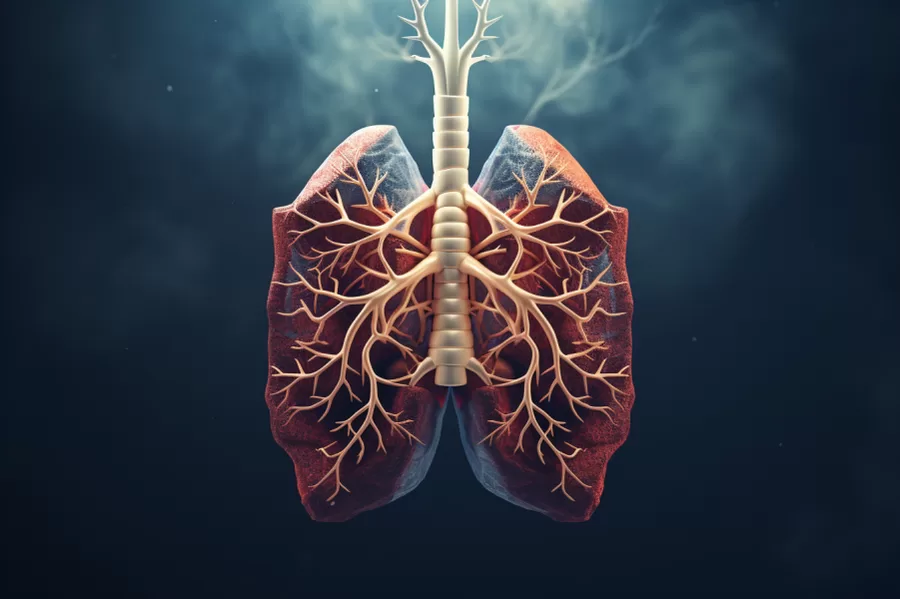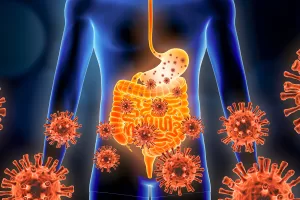Lower respiratory tract infections are often experienced by individuals. Let’s have a closer look at symptoms and treatments of the most common infections to obtain crucial information on how to defend respiratory health.
Lower Respiratory Tract
The lower respiratory tract includes the lungs and connected structures, responsible for gas exchange. It involves the bronchi, bronchioles, and alveoli, where oxygen is absorbed and carbon dioxide is emitted during the breathing process.
Bronchi
The bronchi represent the major airway passages in the lower respiratory tract, branching from the trachea and leading to the lungs. They distribute air to the bronchioles, ensuring effective gas exchange in the alveoli.
Bronchioles
Bronchioles, in turn, represent smaller airway branches in the lower respiratory tract. They are responsible for connecting the bronchi to the alveoli. Bronchioles regulate airflow and perform an essential role in delivering air to the respiratory surface for gas exchange.
Lungs
The lungs are important organs in the lower respiratory tract responsible for gas exchange. They contain millions of alveoli where oxygen is absorbed and carbon dioxide is emitted, alleviating the exchange of gasses during respiration.
Alveoli
Alveoli represent tiny air sacs in the lower respiratory tract, located in the lungs. They are the main site for gas exchange, where oxygen is absorbed into the bloodstream, and carbon dioxide is emitted during breathing.
What is a Lower Respiratory Tract Infection
A lower respiratory tract infection represents a condition that affects the lungs and airways, involving bronchitis and pneumonia. It is caused by fungi, bacteria, or viruses and results in diverse symptoms, particularly, coughing, difficulty breathing, and chest discomfort. The lower respiratory tract infection may be serious and demand medical assistance.
Common Lower Respiratory Tract Infection
Common lower respiratory tract infections like bronchitis and pneumonia, affect the airways and lungs, resulting in various symptoms such as chest discomfort, shortness of breath, cough, and others. Prompt medical examination is crucial for accurate diagnosis and proper treatment.
Pneumonia
Pneumonia is known as a respiratory infection that causes inflammation of the lungs. It may be classified into community-acquired, hospital-acquired, and aspiration pneumonia. Types of pneumonia involve bacterial, fungal, aspiration, and viral pneumonia.
Symptoms
Pneumonia symptoms involve cough, fever, difficulty breathing, and chest pain. Other signs may involve bluish skin, tiredness, and rapid breathing. Ask for medical aid if symptoms worsen or persist.
Treatment
Pneumonia treatment may depend on the cause and severity. For instance, bacterial pneumonia may be managed with antibiotics, while antivirals are utilized for viral pneumonia. Supportive care like rest, hydration, and temperature drop is likewise essential for recovery.
Bronchitis
Bronchitis is an inflammation of the bronchial tubes. Types involve acute and chronic bronchitis. Acute bronchitis is commonly caused by viruses and passes off within weeks, while chronic bronchitis is a long-term condition usually connected with smoking and demands constant treatment.
Symptoms
Bronchitis symptoms involve persistent cough with mucus production, shortness of breath, wheezing, and chest discomfort. Acute bronchitis may be accompanied by cold or flu-like symptoms. At the same time, symptoms of chronic bronchitis have a tendency to be more persistent and severe.
Treatment
Bronchitis treatment may depend on the type and the major cause. Acute bronchitis caused by viruses commonly passes off with rest and supportive care. If individuals experience chronic bronchitis, quitting smoking and managing symptoms with the help of bronchodilators, steroids, and pulmonary rehabilitation are widespread approaches.
Bronchiolitis
Bronchiolitis is a viral infection that causes inflammation in the small airways of the lungs (bronchioles). It usually affects infants and young children. Types involve viral bronchiolitis caused by respiratory syncytial virus and other viral agents.
Symptoms
Bronchiolitis symptoms in infants and young children involve coughing, rapid breathing, fever, wheezing, nasal congestion, and others. Severe cases may result in difficulty feeding and breathing, demanding immediate medical assistance.
Treatment
Bronchiolitis treatment is directed at facilitating symptoms as it is commonly caused by viruses. Supportive care involves supporting hydration, utilizing a cool-mist humidifier, and administering fever-reducing medications. In severe cases, hospitalization may be required for oxygen therapy and monitoring.
Tuberculosis
Tuberculosis represents an infectious disease caused by Mycobacterium tuberculosis bacteria. Types involve pulmonary tuberculosis affecting the lungs and extrapulmonary tuberculosis affecting other parts of the body. It is distributed through the air when an infected individual coughs or sneezes.
Symptoms
Tuberculosis symptoms vary but usually involve persistent cough, sometimes with blood, weight loss, fever, chest pain, night sweats, and tiredness. If you experience these symptoms, ask for medical aid for early detection and treatment.
Treatment
Tuberculosis treatment includes a combination of antibiotics for a definite duration (commonly 6-9 months). Directly observed therapy (DOT) ensures appropriate medication adherence. Early diagnosis and treatment are of decisive importance to avert complications and decrease transmission.
Risk Factors and Causes
Lower respiratory tract infections are usually caused by viruses or bacteria, affecting the lungs and airways. General risk factors involve smoking, exposure to pollutants, age, weakened immune systems, and others. Prompt medical assistance is crucial for managing lower respiratory tract infections.
Age and immunity
Age performs an essential role in lower respiratory tract infection susceptibility. Aged people and young children are at higher risk because of weaker immune systems. People with weakened immune systems are likewise more vulnerable to severe lower respiratory tract infections.
Smoking and environmental factors
Smoking considerably enhances the risk of lower respiratory tract infections by damaging the respiratory system. Moreover, exposure to environmental pollutants like air pollution or secondhand smoke may make worse lower respiratory tract infection susceptibility and severity.
Chronic conditions such as asthma or COPD
Chronic conditions such as asthma or chronic obstructive pulmonary disease are considerable risk factors for lower respiratory tract infections. These conditions weaken the respiratory system, making people more susceptible to infections in the lower airways and lungs.
Exposure to infectious agents
Exposure to infectious agents like viruses and bacteria is a major cause of lower respiratory tract infections. Tight contact with infected people or contaminated surfaces may result in transmission of these agents, leading to respiratory infections.
Diagnosis
Diagnosis of lower respiratory tract infections includes medical history and physical examination, lab tests, clinical evaluation, and others. Advanced imaging and molecular techniques may assist in identifying the causative agents and defining the proper treatment for these serious infections.
Medical history and physical examination
Diagnosing lower respiratory tract infections starts with a careful medical history and physical examination. The clinician estimates symptoms, risk factors, and lung sounds, which grant crucial clues for further diagnostic tests and proper management.
Lab tests
Lab tests are of decisive importance for diagnosing lower respiratory tract infections. Antigen detection assays, blood tests, and sputum cultures assist in identifying the causative pathogens. These results aid clinicians to select the most effective treatment for these infections.
Imaging
Imaging likewise performs an essential role in diagnosing lower respiratory tract infections. Chest X-rays and CT scans grant valuable information about lung abnormalities, helping to identify the extent and nature of the infection, resulting in better patient management.
Lower Respiratory Tract Infection Treatment
Lower respiratory tract infection treatment commonly includes rest, symptom management, antibiotics, and hydration. Note that severe cases may demand hospitalization and supportive care. Early diagnosis and prompt treatment are essential for successful recovery and prevention of complications.
Medications
Lower respiratory tract infection treatment with medications usually involves antibiotics to struggle with bacterial infections. Antiviral drugs may be prescribed for viral infections such as influenza. Bronchodilators may assist in opening airways, while corticosteroids decrease inflammation. The concrete medication regimen may depend on the type and severity of the infection.
Vaccines
Lower respiratory tract infection prevention is possible with the assistance of vaccines. For instance, influenza and pneumococcal vaccines may defend against definite viral and bacterial infections. These vaccines aid in decreasing the risk of severe respiratory illnesses and complications, especially in vulnerable populations like individuals with weakened immune systems, aged people, and young children. Regular vaccination campaigns are crucial to support community immunity and struggle with lower respiratory tract infections.
Lifestyle changes
In addition to medical interventions, lifestyle alterations may likewise perform an essential role in treating lower respiratory tract infections. For instance, shunning exposure to secondhand smoke and quitting smoking may improve lung health. Sticking to a balanced diet, regular exercise, and sufficient hydration maintain a strong immune system. Compliance with hygiene rules like handwashing and shunning tight contact with sick people assists in averting infection distribution. Adequate rest is likewise important for the body to recover effectively.
Summary
To sum up, lower respiratory tract infections remain a considerable global health issue, affecting millions every year. Early detection, rapid medical intervention, and vaccination programs are of decisive importance in decreasing their burden. Public awareness, compliance with hygiene practices, and uninterrupted research are necessary for struggling with lower respiratory tract infections and defending respiratory health worldwide.
FAQ
What is the most common lower respiratory tract infection?
The most common lower respiratory tract infections are bronchitis, pneumonia, bronchiolitis, and tuberculosis.
What is the main cause of lower respiratory infections?
The main cause of lower respiratory infections is firstly viral or bacterial infections.
How long does a lower respiratory infection last?
The duration of a lower respiratory infection may vary depending on the concrete type of infection, the major health of the affected individual, and whether relevant treatment is administered. As a rule, most respiratory tract infections pass within 1 to 2 weeks.
Do you need antibiotics for a lower respiratory infection?
If your lower respiratory infection is caused by bacteria, your healthcare provider may prescribe antibiotics to assist in struggling with the infection. But if it is caused by a virus, antibiotics will not be effective.






